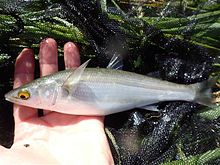Coorong Mullet
| Yellow-eye mullet | |
|---|---|
 |
|
| Scientific classification | |
| Kingdom: | Animalia |
| Phylum: | Chordata |
| Class: | Actinopterygii |
| Order: | Mugiliformes |
| Family: | Mugilidae |
| Genus: |
Aldrichetta Whitley, 1945 |
| Species: | A. forsteri |
| Binomial name | |
|
Aldrichetta forsteri (Valenciennes, 1836) |
|
| Synonyms | |
|
Aldrichetta forsteri nonpilcharda Whitley, 1951 |
|
Aldrichetta forsteri nonpilcharda Whitley, 1951
Mugil forsteri Valenciennes, 1836
Mugil albula Forster, 1801
Agonostoma diemensis (Richardson, 1840)
Dajaus diemensis Richardson, 1840
The yellow-eye mullet (Aldrichetta forsteri) is a mullet of the family Mugilidae, the only species in the genus Aldrichetta. It is found around New Zealand, the Chatham Islands, and southern Australia. In New Zealand it is also known as the sprat or herring, but is neither a true sprat nor a true herring. They are also commonly called the sand mullet.
The back is olive-green, and the belly is silver, usually with a yellow tinge. The eyes are a distinctive bright yellow, as its common name suggests, which easily distinguishes it from other coastal fish. They commonly grow to 25 centimeters. The greatest recorded size is 50 centimeters length and 950 grams weight.
The yellow-eye mullet is similar to the flathead grey mullet, but has a more pointed head and mouth and does not grow as large. Its teeth are larger and more numerous than in a flathead mullet.
They range from the surface to depths of 50 m, but usually only down to 10 m. The yellow-eye mullet schools in large numbers in summer and enters bays and estuaries, and may enter rivers. They feed on benthic detritus, algae and small invertebrates. Occasionally large schools can be seen feeding on the surface. Their greatest known age is seven years.
They have a low habitat damage rate.
The meat of this fish is extremely rich in omega three fatty acids. They are very nice smoked. The black lining surrounding the stomach should be removed before cooking.
...
Wikipedia
